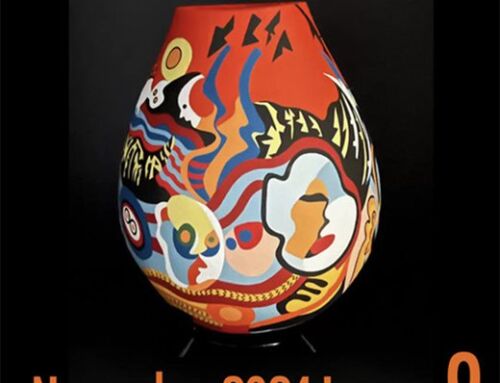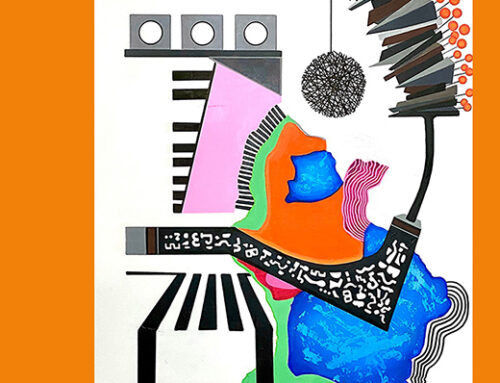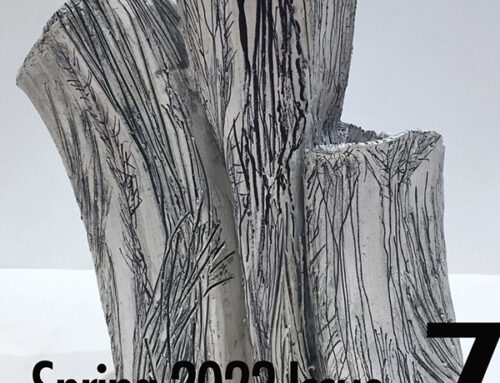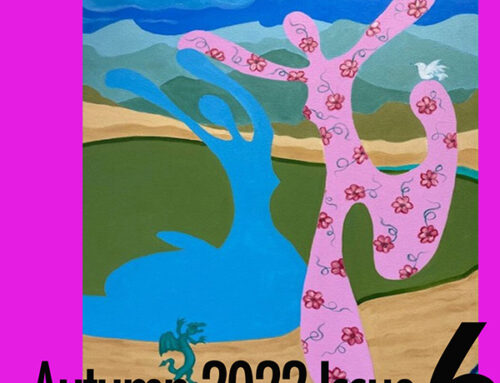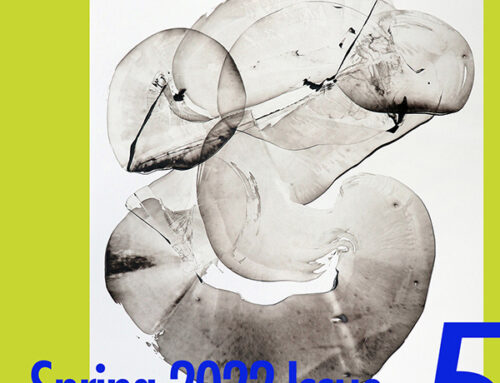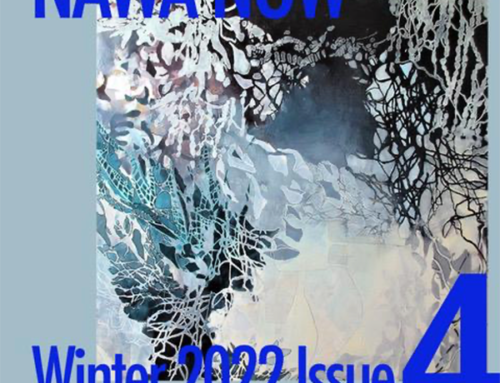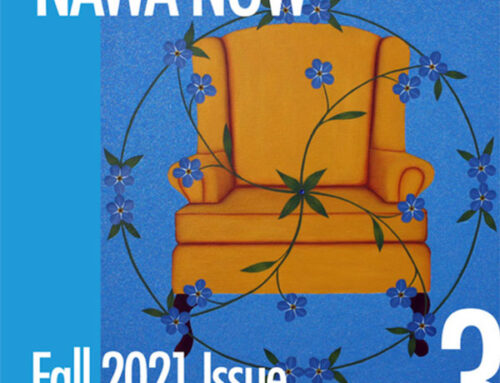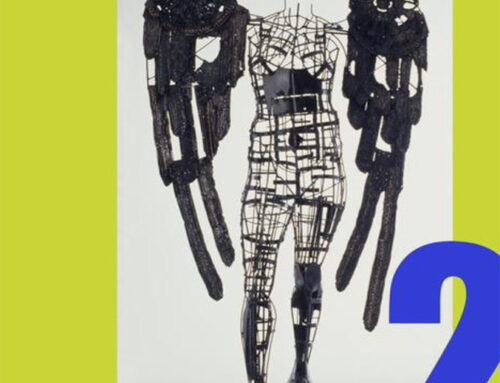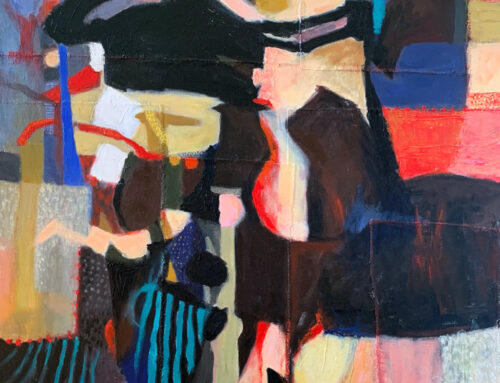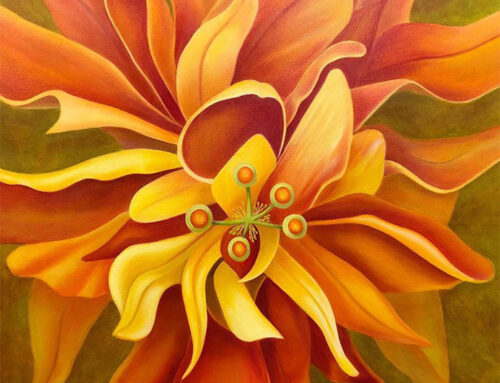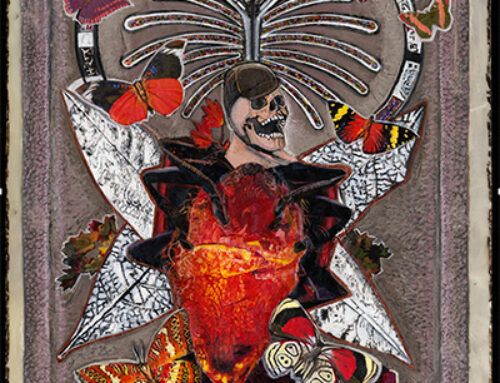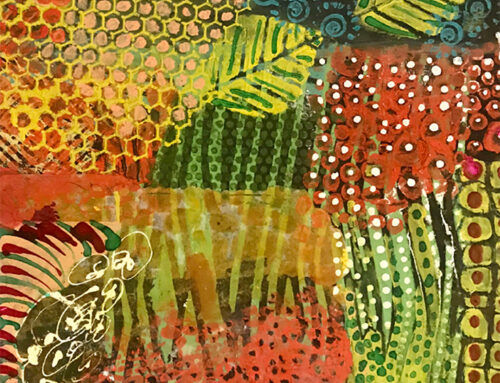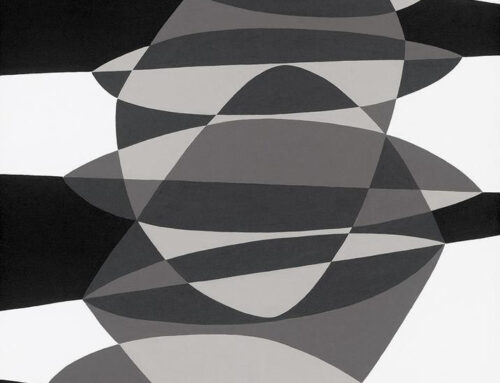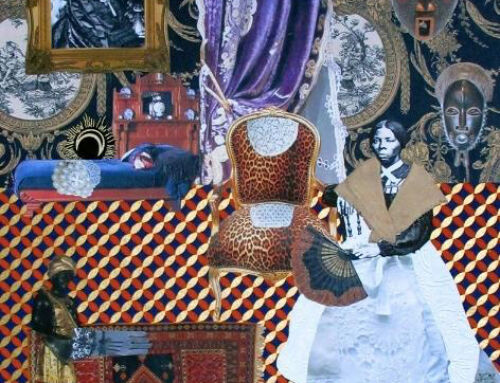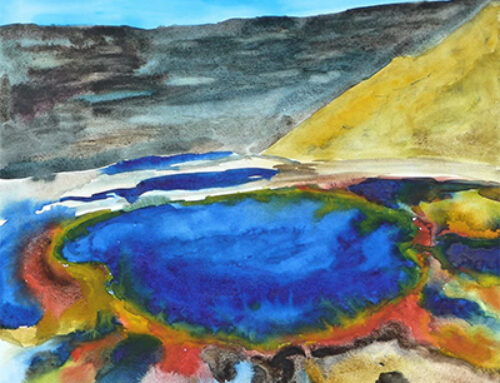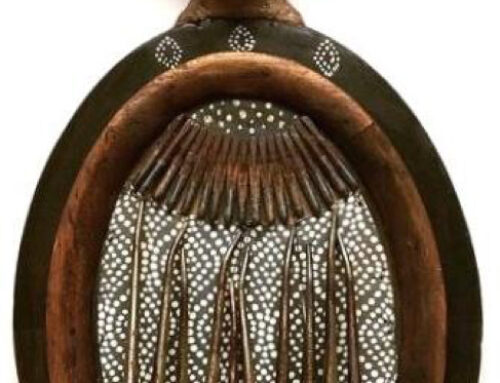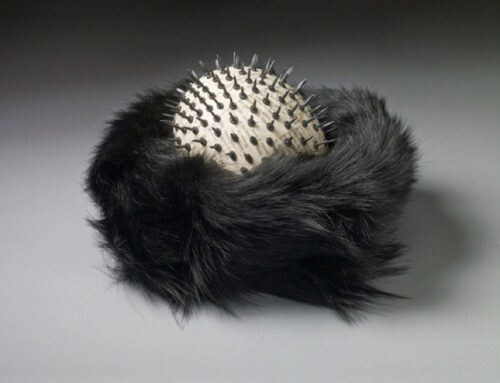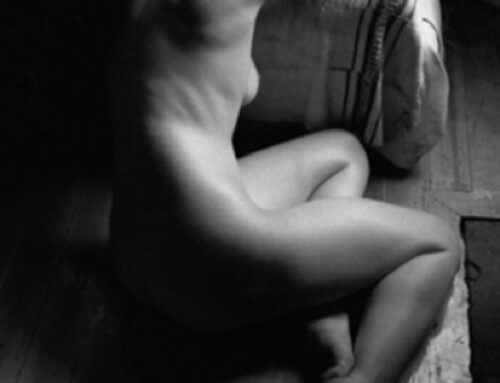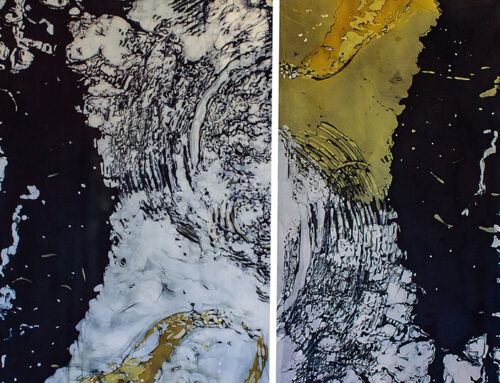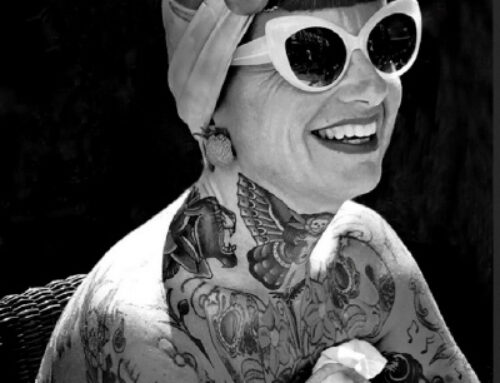Winning entry by Susan Coppock in NAWA’s online Black and White exhibit.
PRESIDENT’S CORNER

Jill Cliffer Baratta
Six years ago, when I joined NAWA, I never would have predicted that I would be President. It was not a goal of mine. However, I opened my mouth and offered my wisdom and experience in committees, and felt valued in my activities as a volunteer member. So, I find myself leading. I enjoy the perspective this gives me into the workings of NAWA, as well as the true friendships I have been able to forge with the members.
With the tight budget, the small staff, and the host of hardworking volunteers, I am duly impressed that we fulfill our mission, even as we keep re-determining to improve. We have devoted donors, for whom it is my wish to prove our worthiness, and help our supporters feel empowered by their donation. It is no small thing to make an offering to a women’s art organization. We’re not starving children, struggling refugees, or cleaning up toxic waste. However, as artists, we are telling the visual stories of our own struggles, as well as those of the victims around us. We are also reflecting the beauty of our surroundings, in spite of the difficulties of the world. Our work wakes up the viewer, but also soothes. So, our role, though it may not always be apparent, IS that of helping save the world from suffering. At the very least, we are creating or maintaining our own happiness so we can function, and fight the battles that must be fought. This is no small feat.
Women know from raising families, or from relationships of any kind, that it is a challenge to communicate effectively. In NAWA, this means among office staff and volunteers, committee chairs with the office staff, central office to the members, between the members, and from chapters to the national office and vice versa. Thus, we have high hopes for the new NAWA Newsletter (please help us name it!). We need to use all available resources to maintain, and when necessary, improve communications. Please read and contribute to our newsletter. In our changing culture, we have so much to read that we sometimes skim, when we need to be thorough. We’re hoping you will want to read our newsletter thoroughly.
Our founders, Edith Mitchill Prellwitz, Grace Fitz-Randolph, Elizabeth S. Cheever, Adele Frances Bedell and Anita C. Ashley clearly knew what we women are all up against, so let’s do our best to fulfill their mission, as we proudly approach our 129th and then our 130th Anniversaries!
Yours in creativity,
Jill Cliffer Baratta, MFA, NAWA
NAWA President
TOOLS OF THE TRADE

Sculpture and Its Tools and Techniques
Sculptural Epoxy: Lucinda Abra
My day job is as a sculpting assistant, a position that I have held in some manner for decades. As such, my experience has been varied in regards to mediums, techniques and the artist’s completed vision. In this article I will be sharing a very interesting material that can be used in such a wide variety of manners: two-step epoxy. It does not require kiln firing and dries inflexible and rigid overnight. Once dried it can have any number of surface treatments, although I prefer oil paint. It can also be covered in spray paint, acrylic or even three-dimensional objects.
One of the two-step epoxies is Free Form Air. Another recommended epoxy is Magic Sculpt. Either can be applied on virtually any supporting surface. As far as supporting surfaces, I have put it on plaster, metal, wood, polyurethane foam and even as a patch material on fired ceramic and bronze. It also works well as a mod material.
Free Form Air is of a lighter consistency and much easier to work with your hands. Magic Sculpt is harder to blend. I use it at stress points, where it works like a charm. Both are low odor and low shrinkage putties.
You may choose to use hand barrier cream before handing the epoxy although both manufactures state the ingredients are not toxic. After scooping out two equal measurements with a metal putty knife, round each of them firmly in equal sized balls with your hands. Now use the putty knife to cut the pieces into either two or four equal parts. Do not allow them to touch, as that will start the chemical reaction that instigates the hardening. Mix completely to a one to one ratio.
A mixture of rubbing alcohol, canola oil and water, with a ratio of 1 part alcohol, 2 parts canola oil, and ten to twelve parts cool water is a good solvent to smooth the joints together as the epoxy pieces are placed on the substructure.
Have a thick plate of glass or marble slab, about 12″ X 9″ X 1″, a small silicon roller, two putty knives, one 3″, another 5″, a spray bottle of water, and the above-mentioned solution ready.
Spray a very light coat of water on the slab and on the silicon roller. This will keep the epoxy from sticking. Apply a steady pressure while rolling, trying to keep the epoxy at about ¼” thick. Pick it up with either of the putty knives and place it on the form. Continue piecing the epoxy, using the finger solution to blend the cuts together. At this point you can make marks into the material, such as scratches or gouges.
After twenty-four hours the sculpture can be lightly sanded to keep the lines true. Wear a dust mask. I also use a small fan to ensure that the loose particles are not blowing in my direction. Both 60 and 80 grit sandpaper work well.
Your piece is now ready for any additional surface treatment you might like. Have fun experimenting!
Order Free Form Air at Smooth-On: https://www.smooth-on.com/
Order Magic Sculpt at http://www.magicsculp.com/
THOUGHTS FROM THE EXECUTIVE DIRECTOR

Executive Director
Susan Hammond:
During the years that I have been involved with fine art, I hear women artists talk about their passion for their art practice. Women who are not involved with creativity do not understand these emotional words. However, creating art is what keeps women artists sane. It keeps them productive, functioning and involved with the world. Frida Kahlo said it best:
“I am happy to be alive as long as I can paint.” – Frida Kahlo
Frida Kahlo, Self Portrait with Thorn Necklace and Hummingbird, 1940
Harry Ransom Center, The University of Texas Austin © 2014
A FIELD TRIP TO NAWA

President Jill Baratta, Executive Director Susan Hammond, Exhibitions Chair Natalia Koren-Kropf, hosted students and their counselor Annette Palmer from James Madison High School in Brooklyn, NY at the NAWA Gallery on December 7th.
ARTIST MUSINGS

Abstract Painter Lee Krasner on Her Early Influences
“‘You have a very strong inner rhythm. You must never lose it.’ Piet Mondrian had said something quite beautiful to me. Hans Hofmann (who was a senior abstract expressionist painter of German origin and temporarily her teacher) was also excited and enthusiastic about what I was doing at this time (around 1938), but his comment was ‘This is so good that you would not know it was done by a woman.’ His was a double-edged compliment. But Mondrian’s evaluation rides through beautifully.”
“I merge what I call the organic with what I call the abstract. As I see both scales, I need to merge these two in the ever-present. What they symbolize I have never stopped to decide. You might want to read it as matter and spirit and the need to merge as against the need to separate. Or it can be read as male and female.”
“I couldn’t run out and do a one-woman job on the sexist aspects of the art world, continue my painting, and stay in the role I was in as Mrs. Pollock. I just couldn’t do that much. What I considered important was that I was able to work, and other things would have to take their turn. You have to brush a lot of stuff out of the way or you get lost in the jungle.”
“I don’t think scale has to do with the physical aspects of the work. I think you can have giant physical size with no statement on it so that is an absurd blow-up of nothingness. And vice versa, you can have a very tiny painting which is monumental in scale. Too often there is confusion as to what’s known as scale in painting. Footage doesn’t mean scale.”
Lee Krasner, source of her woman artist quotes on painting, art and life with Jackson Pollock: “Art Talk, Conversations with 15 woman artists”, Cindy Nemser, 1975, Library of Congress Cataloging-in-Publication Data 1995, p. 73.
EXHIBITS ON YOUR RADAR

Magnetic Fields: Expanding American Abstraction, 1960’s to Today
National Museum of Women in the Arts presents the first U.S. exhibition dedicated exclusively to the presentation of abstraction by an intergenerational group of black women artists. October 13, 2017 – January 21, 2018
See the review from Washington Post.
IN MEMORIAM

Elaine Warshaw
April 11, 1924 – December 1, 2017
Elaine Warshaw was a graduate of Pratt Institutes’ Art school, studied at the Arts Students League and Beaux Arts School and with Elaine Rapp, nationally known sculptor. She was director/teacher of Sculpture Workshop of Merrick, NY for 40 years. Her sculpture has been shown at many top galleries and her carvings are in many fine collections across the country. She was a member of NAWA and is included in the Worlds Who’s Who of Women and Who’s Who of American Art.

Liana Moonie
March 22, 1922 – November 24, 2016
Liana Moonie passed away on November 24, 2016, at the age of 94, after a courageous five-year battle with cancer.
Liana received a Masters degree in teaching in Trieste, Italy. After WWII, she obtained a two-year Visa and traveled to San Francisco, where she worked as an assistant to the Chairman of the Bank of America, translating documents into Italian for the Italian Marshall Plan. There she met her future husband, Clyde W. Moonie, and in 1949 they were married at the Spanish Mission in Carmel. She started
painting seriously in 1969, when her children left home for college and boarding school.
She studied art with Robert Brackman, Edgar Whitney, William Maxwell, Lumen Winters and several other prominent artists. Critics have described her work as “timeless, done with an exquisite sense of design, balance and color harmony” and “possessing great spirituality”.
Liana exhibited in numerous solo and group shows in Florida, Connecticut and New York City. Liana had a deep sense of respect for her women colleagues in the art field, and dedicated herself to numerous organizations. She was president of NAWA from 1987-1989. She established the NAWA collection at the Jane Voorhees Zimmerli Art Museum at Rutgers University, as well as the NAWA Archive at the Alexander Library at Rutgers University. She also founded the NAWA Florida and Massachusetts Chapters. Liana was the recipient of numerous awards and honors throughout her art career, and in 2012 she received the NAWA Lifetime Achievement Award.
Liana’s work is included in several museums and a large number of private and corporate collections. Clyde, her husband of 65 years, predeceased her; she is survived by her son Gregory and daughter Barbara, both of Connecticut.
Liana Moonie will be greatly missed by her family, friends, and the National Association of Women Artists, Inc.

Judith Neuman Cantor
November 17, 1936 – June 19, 2017
Judith grew up in Bethlehem, PA. She graduated from Syracuse University with a BFA degree and received her MFA from Northeastern University. Judith taught pottery and fine art for many years, and also had a pottery business in Bethlehem, PA.
Judith loved to travel and continued her art studies for two years with an artist couple in Haverford, West Wales, UK. Her sister Beth lived in NYC, so Judith decided to move there after both parents passed away. Shortly thereafter, she met her future husband,
Murray Neuman, an endodontist. Murray passed away in 1994.
In 2001, Judith met Walter Hahn while getting off a bus in NYC. They were together since then. They both enjoyed traveling to China and Japan, and shared a love of art.
While in New York City, Judith worked as a graphic designer and upon her retirement she pursued her fine art career. She was juried into NAWA as a new member in 2003.
Judith immediately became an active member and volunteer. Eventually she became the NAWA Exhibition Chair, the Awards Chair, and was then elected as the NAWA President, in 2007.
Judith Neuman Cantor will be missed by her family and her NAWA friends and extended family.
AN INVITATION FROM SANDRA AND MIMI
We’d like to invite all NAWA members to send us news about one and two-person art exhibits (no group exhibits, please), museum acquisitions, Interviews, Book, Magazine and “Who’s Who in American Art” for inclusion in the quarterly NAWA NEWS.

Sandra Bertrand

Mimi Herrera-Pease
We’d like to invite all our members to send us news about their solo or two-person art exhibits (no group exhibits, please) for our quarterly NAWA NEWS. There are currently over 800 active artist members across the country and we want to know what you’re doing. Let NAWA help you spread the word!
We think our NAWA members have a lot to talk about, think about, and celebrate, so we’ve decided to put it all in a quarterly newsletter for your perusal. We hope you have enjoyed this first issue of 2018. And we welcome your feedback!
Other news and perspectives of note will be considered for publication as well, and may be addressed to Mimi at mimi4color@gmail.com . Tell your art friends as well but remember September 15, 2018 is our deadline for the fourth issue.
Just fill out the form below with your own exhibit news and submit. Deadline is September 15, 2018.
[contact-form-7 id=”2673″ title=”Newsletter Form”]



